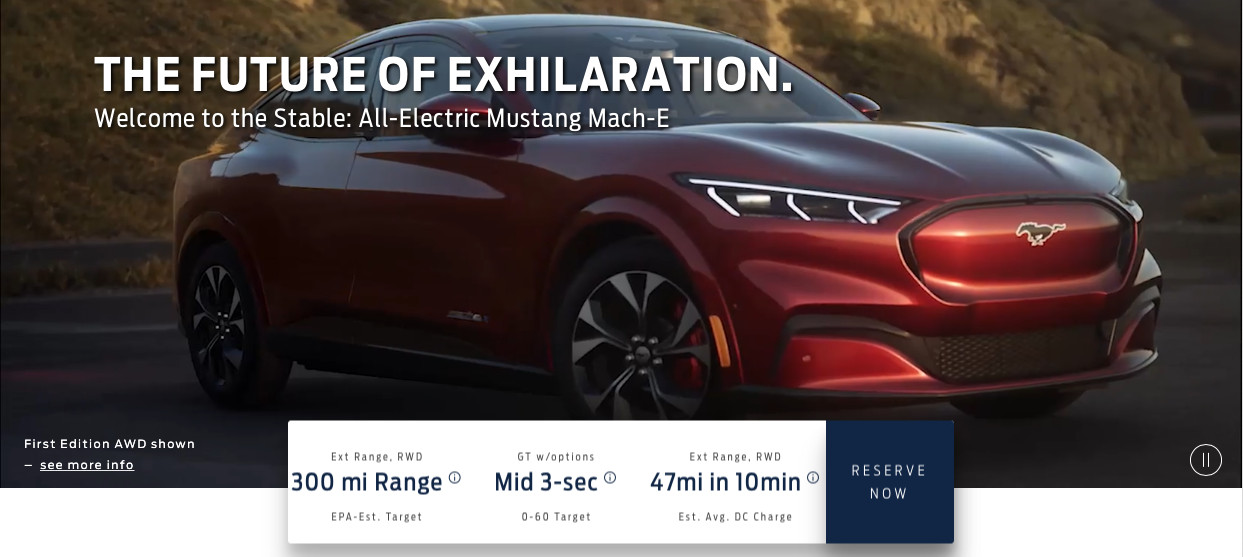
Ford’s first mass-market electric vehicle will hit the ground running with high expectations, starting with its historic badge planted in its grille.
The 2021 Mustang Mach-E is the automaker’s first electric crossover; first Mustang-branded vehicle that’s not a coupe, convertible, nor hatchback; and the first Mustang with electric propulsion from the factory.
The Mach-E goes on sale in late 2020, according to the automaker. It will cost at least $43,895, before applicable federal, state, and local tax incentives. Top versions cost at least $60,500 before options are added—and we expect many options. Some editions offer an estimated range up to 300 miles, while others promise blistering acceleration up to 60 mph in about three seconds.
Review continues below
Ford will offer the Mustang Mach-E in Select, Premium, California Route 1, First Edition, and GT trims.
With the Mach-E, Ford has a rival electric crossover to compete against similar offerings from Tesla and Chevrolet, among others—though many will arrive after the Mach-E.
Style and performance
Keeping true to its promise of “Mustang-inspired” the Mach-E liberally cribs shapes familiar to Mustang fans, pumping up the proportions but keeping the family’s sultry lines.
Most notably, the blunt front end stages an outlined Mustang grille—blanked, like other EVS—and pony-car badge. The front fascia dips low and wide, like the Mustang’s again, with the top shelf wearing thin standard LED lights that arc in toward the grille.
The body sides are sculpted and sporty, organic lines from the front fenders reach toward the rear and a character line races high on the Mach-E’s rear fenders.
The fast roofline commands creative shapes around the rear doors, notably the cutouts and small rear window.
At the back, the bank of rear LED taillights are taken straight from the Mustang—there’s no confusing its inspiration. A small rear window on the hatch tucks below a roof-mounted spoiler. The rear hatch is similarly sculpted and angles in for relief at the rear bumper. Ford may not pay lip service to faux exhaust ports—the Mach-E’s electric powertrain just doesn’t need them.
That’s because the Mach-E relies on electric motors and batteries only.
Available in rear- or all-wheel drive, the Mach-E offers at least three different power outputs from its motors.
Mach-E Select and Premium versions make about 255 horsepower in standard-range configuration and drive the rear or all four wheels. Rear-drive standard range versions may offer up to 230 miles of range, according to Ford. All-wheel-drive models could muster up to 210 miles.
Mach-E California Route 1 and Premium extended-range, rear-drive models make up to 282 hp and are the longest legs of the bunch—Ford says those versions may travel up to 300 miles between charges.
Mach-E Premium and First Edition models with all-wheel drive make 333 hp and have a range up to 270 miles, according to Ford.
Predictably, the performer of the group is the Mach-E GT—a name that it applies to V-8 power—that sprints up to 60 mph in around three seconds when equipped with optional equipment. It’s unclear how powerful the GT is, but Ford says its all-wheel-drive powertrain and 20-inch wheels will dent range down to 235 miles, albeit likely in an exhilarating and entertaining way.
Ford didn’t say what kind of suspension the Mustang Mach-E would use but said it would ride on 18-, 19-, or 20-inch wheels.
Despite offering all-wheel drive, the electric crossover’s low stance speaks more to performance-oriented all-wheel grip—not boulder bashing.
Ford didn’t say how long the Mustang Mach-E would take to charge on a Level 2 charger, which is common for home-charging. On a 150-kw fast-charger, the Mach-E will replenish 47 miles of range in 10 minutes, according to Ford. That should be enough range for most daily drives, although, like any other electric car, owners are likely to charge at home and rarely drain the Mach-E’s battery near empty.
Comfort, safety and features
The first four-door Mustang seems like an afterthought at this point.
The Mach-E promises to seat for at least four, in relative comfort. Why relative? Have you seen the roofline? We haven’t yet been inside the Mach-E, so we’ll reserve judgment on rear-seat head space. What we can see is a tall, tablet-style 15.5-inch touchscreen planted in the center of the dash. Ahead of the driver is a thin 10.2-inch digital instrument cluster and a low cowl that should help outward vision.
Ford upholsters the Mach-E in cloth or synthetic leather upholstery and finishes; wood, brushed metal, and soft-touch surfaces across the dash.
Behind the second row, the Mach-E holds 29 cubic feet of cargo, which expands to 59.6 cubic feet with the seats folded. The front trunk will hold about five cubic feet of cargo, about enough for two soft-sided, small duffel bags or backpacks.
The Mustang Mach-E hasn’t yet been crash-tested, but all models offer Ford’s suite of active safety features including automatic emergency braking, active lane control, and adaptive cruise control. A surround-view camera system is standard on all models above base Reserve, and an automatic parking system and phone-as-a-key system is standard on those trims as well.
Ford hasn’t yet detailed optional features on the Mach-E, but a performance package is likely as is a safety package on Mach-E Reserves.
Mach-E First Editions should arrive in late 2020, with others arriving in early 2021 and GT models arriving in Spring 2021.
0 Kommentarer